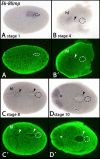New insights into mesoderm and endoderm development, and the nature of the onychophoran blastopore
- PMID: 38267986
- PMCID: PMC10809584
- DOI: 10.1186/s12983-024-00521-7
New insights into mesoderm and endoderm development, and the nature of the onychophoran blastopore
Abstract
Background: Early during onychophoran development and prior to the formation of the germ band, a posterior tissue thickening forms the posterior pit. Anterior to this thickening forms a groove, the embryonic slit, that marks the anterior-posterior orientation of the developing embryo. This slit is by some authors considered the blastopore, and thus the origin of the endoderm, while others argue that the posterior pit represents the blastopore. This controversy is of evolutionary significance because if the slit represents the blastopore, then this would support the amphistomy hypothesis that suggests that a slit-like blastopore in the bilaterian ancestor evolved into protostomy and deuterostomy.
Results: In this paper, we summarize our current knowledge about endoderm and mesoderm development in onychophorans and provide additional data on early endoderm- and mesoderm-determining marker genes such as Blimp, Mox, and the T-box genes.
Conclusion: We come to the conclusion that the endoderm of onychophorans forms prior to the development of the embryonic slit, and thus that the slit is not the primary origin of the endoderm. It is thus unlikely that the embryonic slit represents the blastopore. We suggest instead that the posterior pit indeed represents the lips of the blastopore, and that the embryonic slit (and surrounding tissue) represents a morphologically superficial archenteron-like structure. We conclude further that both endoderm and mesoderm development are under control of conserved gene regulatory networks, and that many of the features found in arthropods including the model Drosophila melanogaster are likely derived.
Keywords: Archenteron; Blastopore; Blimp; Mox; Onychophora; T-box transcription factor; Twist; mef2.
© 2024. The Author(s).
Conflict of interest statement
The authors declare that they have no competing interests.
Figures













Similar articles
-
Fate and nature of the onychophoran mouth-anus furrow and its contribution to the blastopore.Proc Biol Sci. 2015 Apr 22;282(1805):20142628. doi: 10.1098/rspb.2014.2628. Proc Biol Sci. 2015. PMID: 25788603 Free PMC article.
-
Investigation of endoderm marker-genes during gastrulation and gut-development in the velvet worm Euperipatoides kanangrensis.Dev Biol. 2017 Jul 1;427(1):155-164. doi: 10.1016/j.ydbio.2017.04.014. Epub 2017 May 2. Dev Biol. 2017. PMID: 28465040
-
Blastopore formation inAmbystoma mexicanum.Wilhelm Roux Arch Entwickl Mech Org. 1973 Jun;173(2):136-163. doi: 10.1007/BF00575139. Wilhelm Roux Arch Entwickl Mech Org. 1973. PMID: 28304708
-
Origin and evolution of endoderm and mesoderm.Int J Dev Biol. 2003;47(7-8):531-9. Int J Dev Biol. 2003. PMID: 14756329 Review.
-
Evolution of the bilaterian mouth and anus.Nat Ecol Evol. 2018 Sep;2(9):1358-1376. doi: 10.1038/s41559-018-0641-0. Epub 2018 Aug 22. Nat Ecol Evol. 2018. PMID: 30135501 Review.
Cited by
-
Single-cell sequencing suggests a conserved function of Hedgehog-signalling in spider eye development.Evodevo. 2024 Sep 26;15(1):11. doi: 10.1186/s13227-024-00230-6. Evodevo. 2024. PMID: 39327634 Free PMC article.
References
-
- Technau U, Scholz CB. Origin and evolution of endoderm and mesoderm. Int J Dev Biol. 2003;47(7–8):531–539. - PubMed
-
- Manton SM. Studies on the Onychophora VII. The early embryonic stages of Peripatopsis, and some general considerations concerning the morphology and phylogeny of the arthropoda. Philos Trans R Soc B-Biol Sci. 1949;233:483–580.
LinkOut - more resources
Full Text Sources

